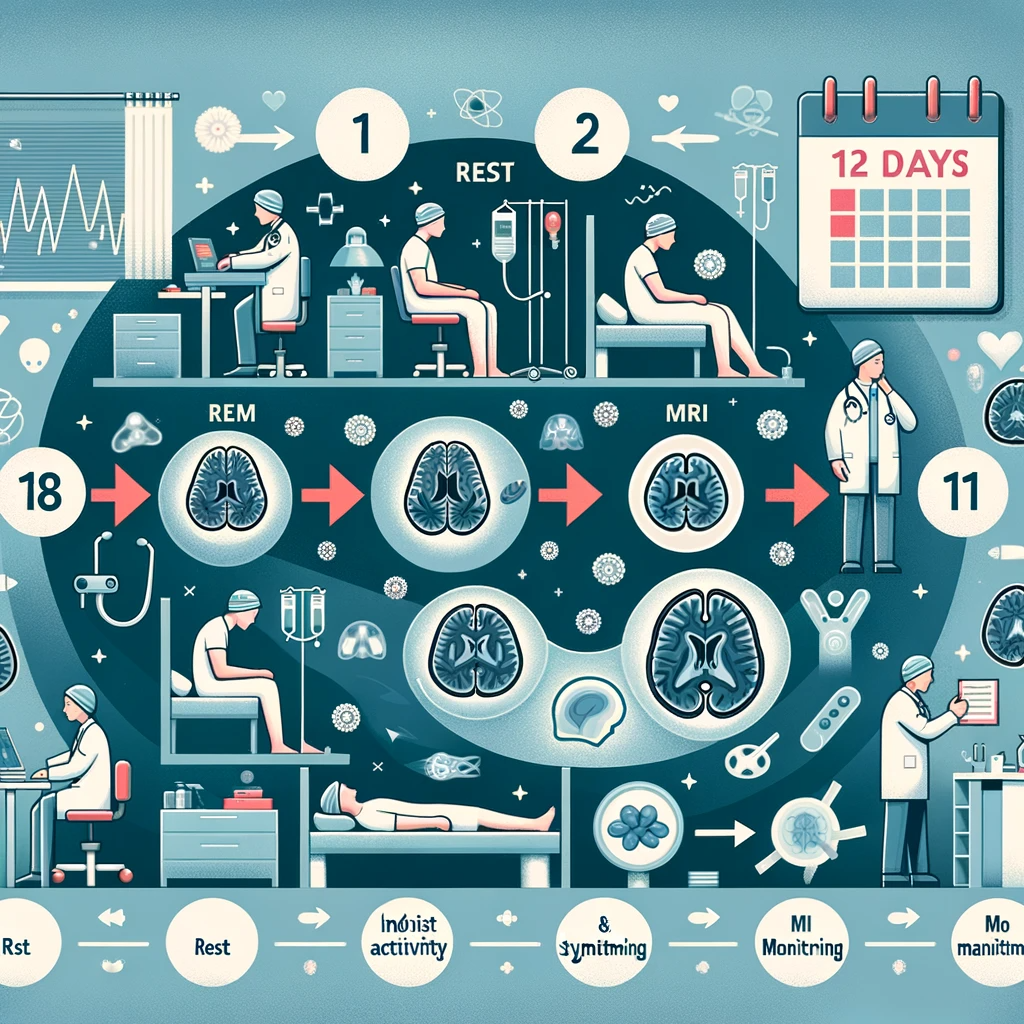Concussions are a common occurrence in sports and can also happen in everyday life. They are a type of mild traumatic brain injury, caused by a bump, blow, or jolt to the head. While most people recover from a concussion within a few weeks, it is essential to properly manage and treat the injury to ensure a full recovery and prevent potential long-term consequences. This is where the 12-day concussion protocol comes into play. Developed by medical professionals and concussion experts, this protocol outlines a step-by-step process for safely returning an individual to physical and cognitive activities after a concussion. The goal of this protocol is to gradually and systematically reintroduce physical and cognitive exertion to allow the brain to heal and reduce the risk of re-injury. In this article, we will delve into the details of the 12-day concussion protocol, how it works, and why it is crucial for concussion management. Whether you are an athlete, a parent, or a healthcare professional, understanding this protocol is vital in ensuring a safe and successful recovery from a concussion.
Overview of 12-day concussion protocol
The 12-day concussion protocol is a comprehensive framework designed to guide healthcare professionals in the assessment, management, and rehabilitation of individuals who have suffered a concussion. This evidence-based protocol aims to ensure a safe and gradual return to normal activities, including both physical and cognitive exertion. The protocol emphasizes a step-by-step approach, starting with a period of rest and gradually introducing light aerobic exercise, followed by more challenging physical activities and sport-specific drills. Throughout the 12 days, healthcare professionals closely monitor the individual’s symptoms and progress to ensure a safe and successful recovery. By following this protocol, healthcare providers can effectively manage concussions and promote optimal recovery for their patients.
Concussion Protocol Overview
- Rest and limited screen time
- Physical and cognitive rest
- Slow re-introduction to activities
- Regular symptom check-ins
- Gradual return to physical activity
- Clearance from healthcare professional before full return to play.
Step-by-step guide to recovery
Recovery from a concussion requires a step-by-step approach that prioritizes the individual’s well-being and promotes gradual progression towards normal activities. The first step in the recovery process involves a period of rest, allowing the brain to heal and minimizing the risk of exacerbating symptoms. During this time, it is crucial to avoid activities that may increase symptoms, such as physical exertion and cognitive tasks. Once symptoms have subsided, the next step is to gradually introduce light aerobic exercise, such as walking or stationary cycling, under the guidance of a healthcare professional. This helps to improve blood flow and promote overall recovery. As the individual progresses and symptoms continue to improve, more challenging physical activities and sport-specific drills can be introduced, taking into account the individual’s tolerance and response. Throughout the recovery process, close monitoring of symptoms and progress is essential to ensure that the individual is not pushing themselves too hard and risking setbacks. By following this step-by-step guide to recovery, individuals can effectively navigate their concussion rehabilitation journey and work towards a full and successful recovery.
12-Day Concussion Protocol Steps
- Rest and avoid physical activity
- Monitor symptoms and report to the doctor
- Follow the prescribed medication plan
- Gradually increase physical and mental activity
- Attend follow-up appointments
- Resume normal activities as symptoms improve
Importance of rest and monitoring
In the context of the 12-day concussion protocol, rest and monitoring play vital roles in ensuring a safe and effective recovery. Rest allows the brain to heal and reduces the risk of further injury by avoiding activities that may exacerbate symptoms. It provides the necessary time for the brain to restore its normal function and for symptoms to subside. Monitoring is equally important as it allows healthcare professionals to closely track the individual’s progress and adjust the treatment plan accordingly. By regularly assessing symptoms, cognitive function, and physical abilities, healthcare providers can make informed decisions about the appropriate timing and intensity of activities to gradually reintroduce to the individual’s routine. This careful monitoring ensures that the individual’s recovery remains on track, minimizing the potential for setbacks and optimizing long-term outcomes.
Rest and monitoring guidelines
- Limit screen time
- Avoid physical activity
- Get plenty of sleep
- Monitor for symptoms
- Take breaks from stimuli
- Follow the doctor’s instructions closely
Gradual return to physical activity
As the individual progresses through the 12-day concussion protocol, a gradual return to physical activity becomes an integral part of the recovery process. It is important to note that this return should be guided by healthcare professionals and implemented in a systematic and controlled manner. The purpose of this gradual reintroduction is to allow the brain and body to adapt to increasing levels of exertion while minimizing the risk of symptom recurrence or exacerbation. This gradual progression may include activities such as light aerobic exercises, stretching, and balance training, which can be gradually intensified over time. It is crucial to closely monitor the individual’s symptoms and response to each activity, adjusting the pace and intensity accordingly. By following this gradual approach, individuals can safely rebuild their physical capabilities and regain their pre-injury level of function, promoting a successful and sustainable recovery.
Guidelines for Return
- Start with light aerobic exercise
- Increase duration and intensity gradually
- Monitor for symptoms and stop if they occur
- Incorporate balance and coordination exercises
- Introduce non-contact activities
- Resume full contact activities only when cleared by a doctor
Consulting with a medical professional
When it comes to navigating the complexities of the 12-day concussion protocol, consulting with a medical professional is essential. Their expertise and knowledge in the field of concussion management can provide invaluable guidance throughout the recovery process. A medical professional can assess the severity of the concussion, monitor symptoms, and determine when it is appropriate to progress to the next stage of the protocol. They can also provide personalized recommendations based on the individual’s unique circumstances, ensuring a tailored approach to their recovery. Consulting with a medical professional not only ensures the safety and well-being of the individual but also increases the likelihood of a successful and optimal outcome.
Medical Consultation Steps
- Assessing symptoms and severity of concussion
- Performing neurological exams and cognitive testing
- Monitoring for changes in symptoms and recovery progress
- Implementing rest and symptom management strategies
- Educating on return-to-activity guidelines and risks
- Creating a personalized concussion treatment plan
In conclusion, the 12-day concussion protocol is a critical tool for ensuring the safe return of athletes to their respective sports after a head injury. With careful medical evaluation and monitoring, this protocol aims to prevent potential long-term effects of concussions while allowing athletes to safely resume their activities. As our understanding of concussions continues to evolve, athletes, coaches, and medical professionals need to prioritize safety and follow the recommended guidelines for a successful recovery.
FAQ
What is the purpose of the 12-day concussion protocol?
The purpose of the 12-day concussion protocol is to ensure the safety and well-being of athletes who have suffered a concussion. It is designed to provide a structured approach for evaluating and managing concussions, allowing athletes to gradually return to their sport after a period of rest and recovery. The protocol includes various stages of exertion and cognitive testing to monitor the athlete’s progress, ensuring that they are fully healed before resuming full activity. By following this protocol, the risk of re-injury and potential long-term consequences of concussions can be minimized.
How does the 12-day concussion protocol help in the recovery process?
The 12-day concussion protocol helps in the recovery process by providing a structured approach to gradually reintroduce physical and cognitive activities. This protocol allows the brain to heal and reduces the risk of exacerbating symptoms or causing further injury. It involves rest initially, followed by a gradual increase in activity levels as symptoms subside. By closely monitoring symptoms and gradually increasing activity, the protocol ensures that athletes or individuals with concussions return to play or daily activities safely and minimizes the risk of complications or prolonged recovery.
What are the key components of the 12-day concussion protocol?
The key components of the 12-day concussion protocol typically include rest, physical and cognitive rest, gradual return to activity, and medical clearance. During the first few days, complete rest is usually recommended to allow the brain to heal. After that, physical and cognitive rest is advised, which involves avoiding activities that could worsen symptoms. Once symptoms improve, a gradual return to activity is initiated, starting with light aerobic exercise and gradually increasing intensity. Medical clearance is obtained before returning to full contact or high-risk activities. It is important to note that specific protocols may vary, and it is best to consult a healthcare professional for personalized guidance.
Are there any specific guidelines or criteria that determine when an athlete can progress through the different stages of the 12-day concussion protocol?
Yes, some specific guidelines and criteria determine when an athlete can progress through the different stages of the 12-day concussion protocol. These guidelines and criteria are typically based on standardized concussion assessment tools, such as the SCAT5 or the King-Devick test, as well as clinical judgment. The athlete must demonstrate symptom resolution, cognitive recovery, and a gradual return to physical activity without any recurrence of symptoms. Each stage of the protocol has specific requirements that the athlete must meet before progressing to the next stage, with the overall goal of ensuring their safety and minimizing the risk of re-injury or complications.
What are the potential risks or complications if an athlete does not follow the 12-day concussion protocol properly?
If an athlete does not follow the 12-day concussion protocol properly, they may be at risk for prolonged symptoms, delayed recovery, and increased susceptibility to future concussions. Ignoring the prescribed rest and activity restrictions can exacerbate the initial injury and lead to more severe and long-lasting symptoms. Furthermore, returning to play too soon can put the athlete at risk for a second concussion, which can have more severe consequences and potentially even be life-threatening. Athletes must adhere to the concussion protocol to ensure proper healing and minimize the risk of complications.



